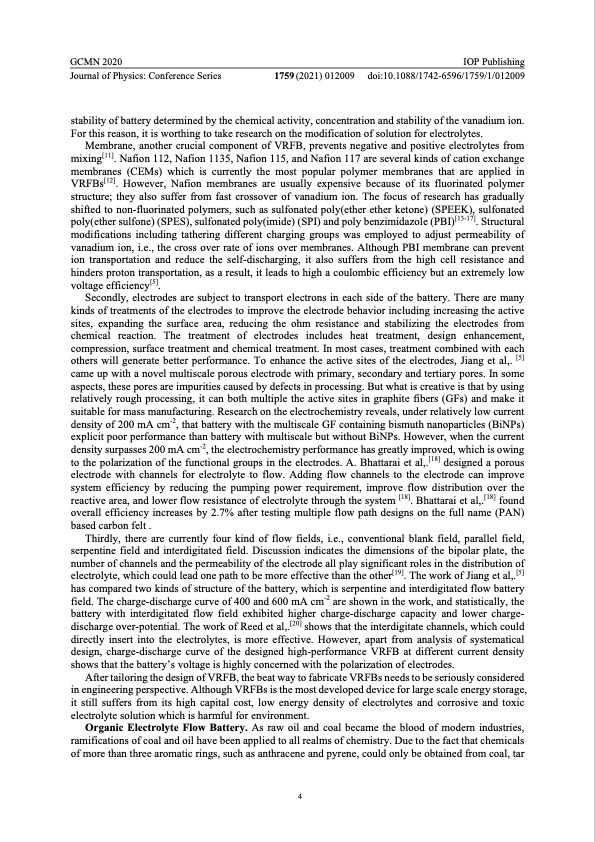
PDF Publication Title:
Text from PDF Page: 005
GCMN 2020 IOP Publishing Journal of Physics: Conference Series 1759 (2021) 012009 doi:10.1088/1742-6596/1759/1/012009 stability of battery determined by the chemical activity, concentration and stability of the vanadium ion. For this reason, it is worthing to take research on the modification of solution for electrolytes. Membrane, another crucial component of VRFB, prevents negative and positive electrolytes from mixing[11]. Nafion 112, Nafion 1135, Nafion 115, and Nafion 117 are several kinds of cation exchange membranes (CEMs) which is currently the most popular polymer membranes that are applied in VRFBs[12]. However, Nafion membranes are usually expensive because of its fluorinated polymer structure; they also suffer from fast crossover of vanadium ion. The focus of research has gradually shifted to non-fluorinated polymers, such as sulfonated poly(ether ether ketone) (SPEEK), sulfonated poly(ether sulfone) (SPES), sulfonated poly(imide) (SPI) and poly benzimidazole (PBI)[13-17]. Structural modifications including tathering different charging groups was employed to adjust permeability of vanadium ion, i.e., the cross over rate of ions over membranes. Although PBI membrane can prevent ion transportation and reduce the self-discharging, it also suffers from the high cell resistance and hinders proton transportation, as a result, it leads to high a coulombic efficiency but an extremely low voltage efficiency[5]. Secondly, electrodes are subject to transport electrons in each side of the battery. There are many kinds of treatments of the electrodes to improve the electrode behavior including increasing the active sites, expanding the surface area, reducing the ohm resistance and stabilizing the electrodes from chemical reaction. The treatment of electrodes includes heat treatment, design enhancement, compression, surface treatment and chemical treatment. In most cases, treatment combined with each others will generate better performance. To enhance the active sites of the electrodes, Jiang et al,. [5] came up with a novel multiscale porous electrode with primary, secondary and tertiary pores. In some aspects, these pores are impurities caused by defects in processing. But what is creative is that by using relatively rough processing, it can both multiple the active sites in graphite fibers (GFs) and make it suitable for mass manufacturing. Research on the electrochemistry reveals, under relatively low current density of 200 mA cm-2, that battery with the multiscale GF containing bismuth nanoparticles (BiNPs) explicit poor performance than battery with multiscale but without BiNPs. However, when the current density surpasses 200 mA cm-2, the electrochemistry performance has greatly improved, which is owing to the polarization of the functional groups in the electrodes. A. Bhattarai et al,.[18] designed a porous electrode with channels for electrolyte to flow. Adding flow channels to the electrode can improve system efficiency by reducing the pumping power requirement, improve flow distribution over the reactive area, and lower flow resistance of electrolyte through the system [18]. Bhattarai et al,.[18] found overall efficiency increases by 2.7% after testing multiple flow path designs on the full name (PAN) based carbon felt . Thirdly, there are currently four kind of flow fields, i.e., conventional blank field, parallel field, serpentine field and interdigitated field. Discussion indicates the dimensions of the bipolar plate, the number of channels and the permeability of the electrode all play significant roles in the distribution of electrolyte, which could lead one path to be more effective than the other[19]. The work of Jiang et al,.[5] has compared two kinds of structure of the battery, which is serpentine and interdigitated flow battery field. The charge-discharge curve of 400 and 600 mA cm-2 are shown in the work, and statistically, the battery with interdigitated flow field exhibited higher charge-discharge capacity and lower charge- discharge over-potential. The work of Reed et al,.[20] shows that the interdigitate channels, which could directly insert into the electrolytes, is more effective. However, apart from analysis of systematical design, charge-discharge curve of the designed high-performance VRFB at different current density shows that the battery’s voltage is highly concerned with the polarization of electrodes. After tailoring the design of VRFB, the beat way to fabricate VRFBs needs to be seriously considered in engineering perspective. Although VRFBs is the most developed device for large scale energy storage, it still suffers from its high capital cost, low energy density of electrolytes and corrosive and toxic electrolyte solution which is harmful for environment. Organic Electrolyte Flow Battery. As raw oil and coal became the blood of modern industries, ramifications of coal and oil have been applied to all realms of chemistry. Due to the fact that chemicals of more than three aromatic rings, such as anthracene and pyrene, could only be obtained from coal, tar 4PDF Image | Emerging Aqueous Flow Batteries and Perspectives

PDF Search Title:
Emerging Aqueous Flow Batteries and PerspectivesOriginal File Name Searched:
Zhang_2021_J_Phys_Conf_Ser_1759_012009.pdfDIY PDF Search: Google It | Yahoo | Bing
Salgenx Redox Flow Battery Technology: Salt water flow battery technology with low cost and great energy density that can be used for power storage and thermal storage. Let us de-risk your production using our license. Our aqueous flow battery is less cost than Tesla Megapack and available faster. Redox flow battery. No membrane needed like with Vanadium, or Bromine. Salgenx flow battery
| CONTACT TEL: 608-238-6001 Email: greg@salgenx.com | RSS | AMP |